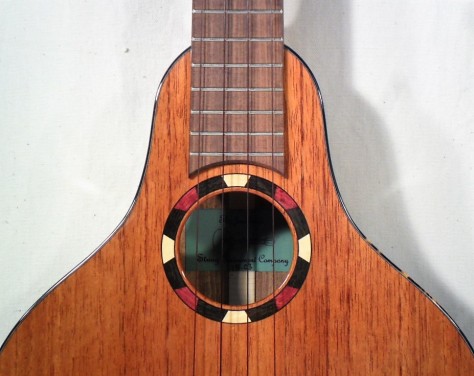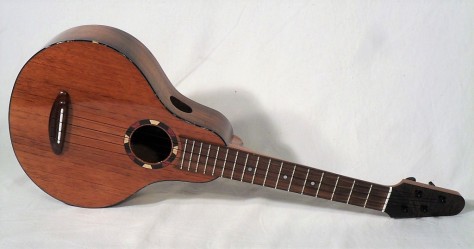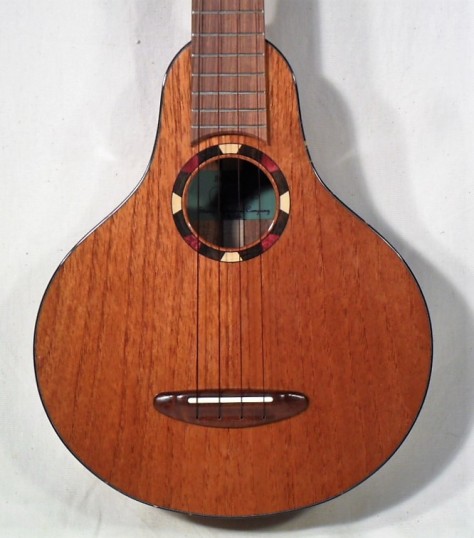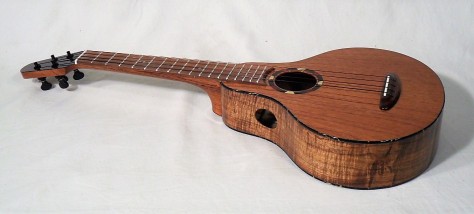I just finished a batch of pear shaped tenor ukes and I thought I‘d share some pictures. After making 24 long neck sopranos in all sorts of timbers and basically to the Grellier (Martin) drawings I wanted to design a ukulele from scratch. I love the look of instruments with tailpieces and floating bridges and this was where this project began. Everything that I read about ukes with floating bridges said that they suffered from limited volume so I decided to do as much as I could to overcome that problem. My main approach was to try and maximise the free vibrating area of the soundboard while maintaining the SB area of a traditional tenor shape. I liked the pear shape of the an old Washburn parlour guitar from the 20’s that I had seen and the shape gave me the idea to take some area from around the front bouts and add it to the back bouts which would increase the width. I build in batches of 4 and decided that two of the instruments would have normal fixed bridges and act as a control to gauge success in overcoming the floating bright attenuation issue. I made all 4 ukes out of exactly the same timbers and to the same scale length and opted experiment with different bracing patterns to see how they affected the sound.
I read somewhere that there could be an issue with a floating bridge system causing a compression issue just forward of the sound hole. To compensate for this I used an extended fan braces pattern on one of the floating bridge tenors. For the other floating bridge uke I thought it might be fun and a challenge to do it with a lattice brace system. The cross section of the segments of the lattice are 3mm x 5mm at their biggest and taper down to almost nothing where they end just short of the kerfed linings. To reduce the size of the spruce ladder braces on my previous sopranos I started reinforcing them with a vertical laminated strip of carbon fibre and decided to continue with this approach in these tenors. Seeing as this whole project started with an appreciation of the look of a tailpiece I decided to custom make the ones for these ukes. The strings pass through holes in a mulga dowel which hooks into the chrome plated brass metal bit. I’m very happy with how they look and function. The two fixed bridge ukes have identical fan braces with a carbon fibre bridge patch. I’ve strung one of these with high G and the other with low G. Both floating bridge ukes are strung high G at this time. So, to the specs:
Soundboards and Necks: Spanish Cedar
Back and Sides: Blackwood
Fretboards, Bridges and Headstock Veneer: Mulga
Soundboard Radius: 25’ fixed bridge pair, 15’ floating bridge pair
Back Radius: 15’ for all 4 ukes
Scale Length 18”
Fretboard Profile: Flat
Tuners: Gotoh UPTL
Strings: Worth Browns
Finish: Miratone
And what do they sound like? The two fixed bridge ukes sound just like normal tenors but maybe a little bit brighter. They aren’t any louder than the other tenors that I have played. The fan braced floating bridge one has just as much volume as the fixed bridge ones and is a bit brighter again with a bit less sustain. The lattice braced one is a lot brighter again with even less sustain. It’s maybe 5% down the road to sounding like a banjo. And as to this floating bridge on a nylon string instrument not having enough bridge downforce to transfer the vibration energy discussion. I shaped and polished the soles of the bridges to follow the soundboard radius and they are really well squeezed into place. To move them around slightly to optimise the intonation I have to really push them hard.
The things that I engineered into the floating bridge design to overcome attenuation issues included the items below. I’m not certain the reasoning in some of these ideas is totally solid or that any of them worked but I’m new to this acoustic engineering stuff and gave it my best shot:
Increasing the width of the lower bout to increase the free vibrating area of the soundboard.
A longer scale length
Tail piece design. I wanted to limit string vibration loss into the tail block and I thought that a tortuous path into the design could limit energy transfer.
Carbon Fibre reinforced neck with stiff fretboard.
TUSQ saddle.
A light, stiff and thin (1.8mm) sound board.
cheers
Paul
This slideshow requires JavaScript.





You must be logged in to post a comment.